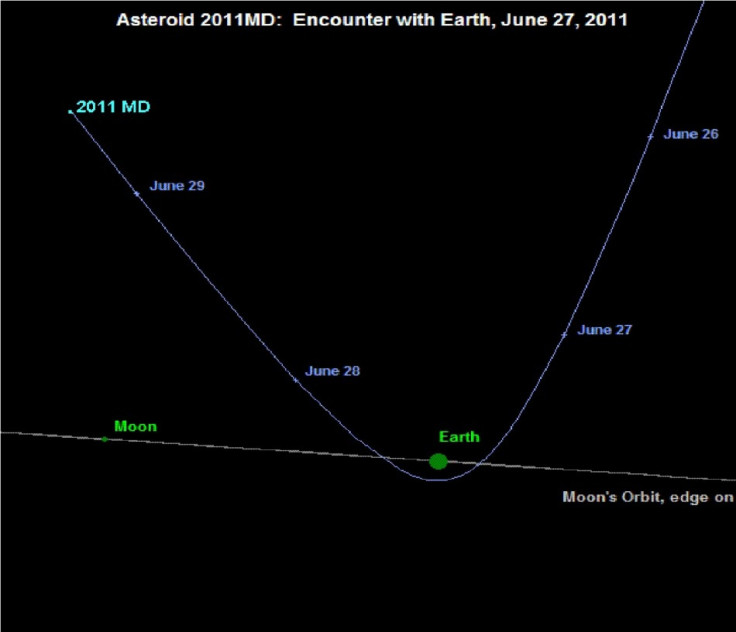Asteroid Set to Miss Earth by 7,500 Miles Today

NASA said Asteroid 2011 MD, a hunk of rock estimated to be anywhere from 16 to 35 feet wide, is going to fly by Earth today at a distance of 7,500 miles above the surface of the planet.
The asteroid will be about 30 times closer to Earth than the existing distance between the planet and the moon, which is around 240,000 miles.
With an orbit similar to Earth's, the asteroid will make the closest approach at 9:30 am EDT on June 27, passing over 7,500 miles (12,000 kilometers) above the Earth's surface. At that particular moment, the asteroid will be sailing high off the coast of Antarctica, almost 2,000 miles (3,218 kilometers) south-southwest of South Africa, NASA said in a statement.
If a rocky asteroid the size of 2011 MD were to enter Earth's atmosphere, it would be expected to burn up high in the atmosphere and cause no damage to Earth's surface, according to NASA's Asteroid Watch.
Asteroid 2011 MD will be the fifth-closest asteroid to graze past Earth, according to the ranking charts of International Astronomical Union's Minor Planet Center in Massachusetts.
In the past, three asteroids have zoomed past Earth at a closer distance, including a tiny asteroid (2011 CQ1) which flew by on February 4 this year after coming as close as 3,400 miles away from Earth's surface.
The fourth, an asteroid named 2008 TC3 had entered Earth's atmosphere on October 7, 2008, but disintegrated into tiny pieces at a height of around 23 miles off the ground.
There won't be much of a spectacle, said Fred Watson from the Australian Astronomical Observatory. But amateur astronomers are still hoping to catch a glimpse of the stunning blue light in the sky.
Asteroid 2011 MD will be visible in moderately-large amateur telescopes for several hours prior to its closest approach, according to Space.com. Despite its close approach, viewing this asteroid is unlikely to be an easy task. The asteroid is not expected to get very bright; about 250 times dimmer than the faintest stars visible to the eye without optical aid.
Closest approach happens around 8:30 a.m. CDT Monday over the far South Atlantic Ocean off the coast of Antarctica. Observers in Australia and New Zealand will be able to catch it in their telescopes at around magnitude 12 about a half hour before closest shave. In the Midwest, the asteroid will be visible as a faint 14.5 magnitude speck moving at a respectable pace across the stars of Serpens low in the western sky in the early morning hours Monday, Bob King said on Astro Bob site.
The Earth is surrounded by 8,099-odd known asteroids or Near-Earth Objects (NEO) of different sizes, whose orbits are dangerously close to Earth's surface, NASA scientists say. Of them, only around 1,000 measure less than 100 feet across, about 827 are asteroids with a diameter of half a mile or longer and about 1236 of them have been classified as Potentially Hazardous Asteroids.
In 2016, NASA will launch the OSIRIS-Rex asteroid probe that will visit a potentially dangerous NEO called 1999 RQ36 in 2020. The scientists say 1999 RQ36, which is 1,900 feet wide, has a 1-in-1,800 chance of hitting Earth in the year 2170, and a 1-in-1,000 chance of crashing in 2182.
The closeness of 2011 MD is a reminder to people that events on Earth have the potential to be shaped by asteroids - 'like the annihilation of the dinosaurs'. It reminds us of our reality in an environment littered with debris of this kind, which is actually the leftovers of the solar system's formation about 4.6 billion years ago, Fred Watson from the Australian Astronomical Observatory said as quoted by ABC News.
© Copyright IBTimes 2024. All rights reserved.





















